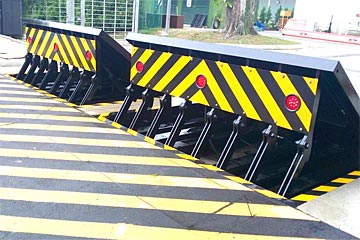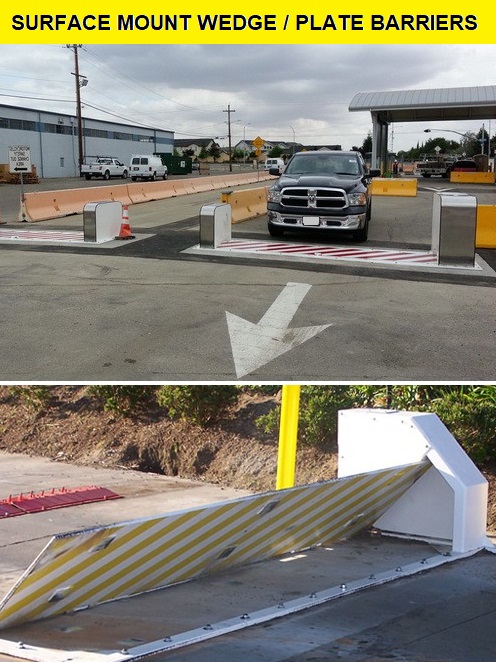Wedge Barriers for Dummies
Wiki Article
The 30-Second Trick For Wedge Barriers


The spring rod 58 is coupled to a web cam(e. g., web cam 80 revealed in FIG. 4) of the training mechanism 50. The springs 60 disposed about the springtime pole 58 are held in compression by spring supports 62, including a fixed spring support 64. That is, the set springtime support 64 is taken care of about the foundation 14 et cetera of the bather 10.
How Wedge Barriers can Save You Time, Stress, and Money.
g., springtime assistance 65 )may be dealt with to the end of the springtime rod 58 to allow compression of the springtimes 60. As the springs 60 are pressed in between the spring supports 62, the springtime assembly 54 generates a pressure acting upon the cam combined to the springtime rod 58 in a direction 66. The remaining force used to the cam web cam deploy the wedge plate 16 may be provided supplied an electromechanical actuator 84 or other various other. The spring setting up 54 and the actuator 84(e. g., electromechanical actuator)might run with each other to convert the cam and raise the wedge plate 16.
As pointed out over, the springtime assembly 54 applies a continuous pressure on the camera, while the electromechanical actuator might be regulated to put in a variable force on the webcam, thus allowing the lifting and reducing( i. e., deploying and retracting )of the wedge plate 16. In certain embodiments, the constant pressure used by the springtime setting up 54 may be adjustable. g., electromechanical actuator) is disabled. As will be valued, the springtime setting up 54 may be covered and safeguarded from debris or other components by a cover plate(e. g., cover plate 68 received FIG. 4) that might be significantly flush with the elevated surface 38 of the structure 14. As stated above, in the deployed position, the wedge plate 16 offers to obstruct access or traveling past the barrier 10. The obstacle 10(e. g., the wedge plate 16 )might block pedestrians or automobiles from accessing a property or pathway. As talked about over, the obstacle 10 is attached to the support 30 protected within the foundation 14,
front brackets 71. Because of this, the link assemblies 72 may pivot and turn to allow the collapse and extension of the link assemblies 72 during retraction and deployment of the bather 10. The linkage assemblies 72 cause movement of the wedge plate 16 to be limited. If a car is traveling towards the deployed wedge plate 16(e. For instance, in one scenario, the security legs 86 may be extended throughoutmaintenance of the barrier 10. When the security legs 86 are deployed, the security legs 86 support the weight of the wedge plate 16 versus the surface 12. As an outcome, the training system 50 may be shut down, serviced, gotten rid of, replaced, and so forth. FIG. 5 is partial viewpoint view of an embodiment of the surface-mounted wedge-style obstacle 10, showing the webcam 80 and the cam surfaces 82 of the training system 50. Specifically, two web cam surfaces 82, which are he said described as reduced cam surface areas 83, are positioned listed below the camera 80. The lower web cam surface areas 83 may be dealt with to the surface 12 (e. For instance, the reduced webcam surface areas 83 and the installing plate 85 might create a single item that is secured to the support 30 by bolts or various other mechanical fasteners. In addition, two web cam surfaces 82, which are described as upper next page web cam surfaces 87, are placed above the camera 80 and coupled to (e. In various other embodiments, stepping in layers or plates may be positioned in between the surface 12 and the reduced cam surface areas 83 and/or the wedge plate 16 and the upper webcam surface areas 87 As pointed out above, the web cam 80 converts along the web cam surface areas 82 when the wedge plate 16 is lifted from the withdrawed setting to the released placement. Furthermore, as stated above, the spring setting up 54 (see FIG. 3 )might offer a pressure acting upon the webcam 80 in the direction 102 through springtime rod 58, which may minimize the pressure the electromechanical actuator 84 is required to put on the camera 80 in order to activate and lift the wedge plate 16. 1 )to the deployed setting(see FIG. 4). As revealed, the web cam 80 includes track wheels 104(e. g., rollers), which get in touch with and equate along the web cam surface areas 82 during operation.
Report this wiki page